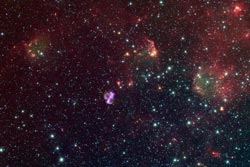Supernova Remnant Is an Unusual Suspect

X-ray: NASA/CXC/PSU/S.Park and J.Lee; IR: NASA/JPL-Caltech <br>This is a composite image of SNR 0104 and its surrounding neighborhood. X-rays from Chandra are shown in purple while infrared data from Spitzer are colored red and green.
In this composite made of X-rays from Chandra shown in purple and infrared data from Spitzer shown in green and red, SNR 0104 looks unlike other likely Type Ia remnants found in our own Galaxy. While objects such as the Kepler and Tycho supernova remnants appear circular, the shape of SNR 0104 in X-rays is not.
Instead, the image is dominated by two bright lobes of emission (seen to the upper right and lower left). The large amount of iron in these lobes indicates that SNR 0104 was likely formed by a Type Ia supernova.
One possible explanation for this structure is that the explosion of the white dwarf itself was strongly asymmetrical and produced two jets of iron. Another possibility is that the complicated environment seen in the image is responsible. The green shells on the left and right side of SNR 0104 correspond to surrounding material that has been swept up by the explosion. So, the unusual shape of the remnant might be caused by a lack of material to the north and south of the star to interrupt the outward path of the stellar debris. This explanation, however, is still in question and scientists hope more data from Chandra and other telescopes will help settle the debate.
The presence of a nearby massive star and the shells of gas and dust seen in the wide-field view from Spitzer shows that SNR 0104 might be located within a star-forming region. This suggests that SNR 0104 may belong to a little-studied class of so-called “prompt” Type Ia supernovas caused by the demise of younger, more massive stars than average. Again, more data will be needed to test this theory.
This research was led by Sangwook Park and Jae-Joon Lee of Penn State University and was presented at the 214th meeting of the American Astronomical Society in Pasadena, California. NASA's Marshall Space Flight Center in Huntsville, Ala., manages the Chandra program for NASA's Science Mission Directorate in Washington. The Smithsonian Astrophysical Observatory controls Chandra's science and flight operations from Cambridge, Mass.
Media Contact
More Information:
http://www.cfa.harvard.eduAll latest news from the category: Physics and Astronomy
This area deals with the fundamental laws and building blocks of nature and how they interact, the properties and the behavior of matter, and research into space and time and their structures.
innovations-report provides in-depth reports and articles on subjects such as astrophysics, laser technologies, nuclear, quantum, particle and solid-state physics, nanotechnologies, planetary research and findings (Mars, Venus) and developments related to the Hubble Telescope.
Newest articles

Silicon Carbide Innovation Alliance to drive industrial-scale semiconductor work
Known for its ability to withstand extreme environments and high voltages, silicon carbide (SiC) is a semiconducting material made up of silicon and carbon atoms arranged into crystals that is…

New SPECT/CT technique shows impressive biomarker identification
…offers increased access for prostate cancer patients. A novel SPECT/CT acquisition method can accurately detect radiopharmaceutical biodistribution in a convenient manner for prostate cancer patients, opening the door for more…

How 3D printers can give robots a soft touch
Soft skin coverings and touch sensors have emerged as a promising feature for robots that are both safer and more intuitive for human interaction, but they are expensive and difficult…





















